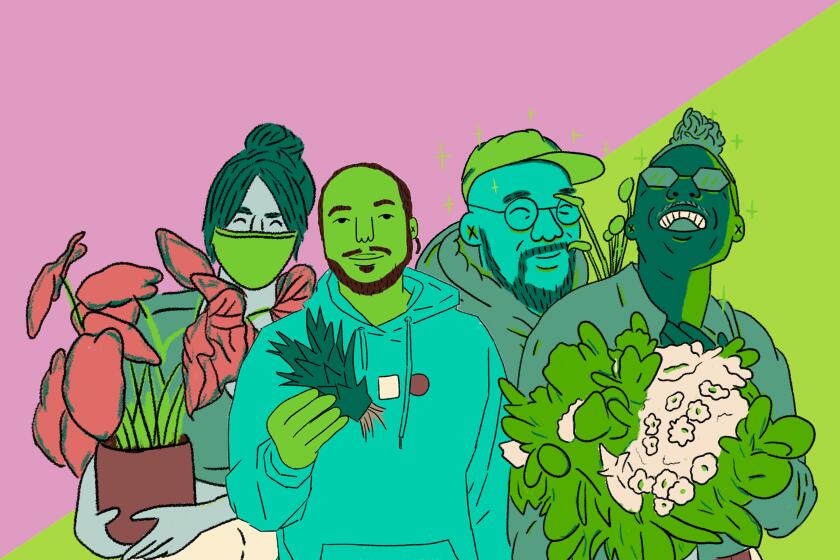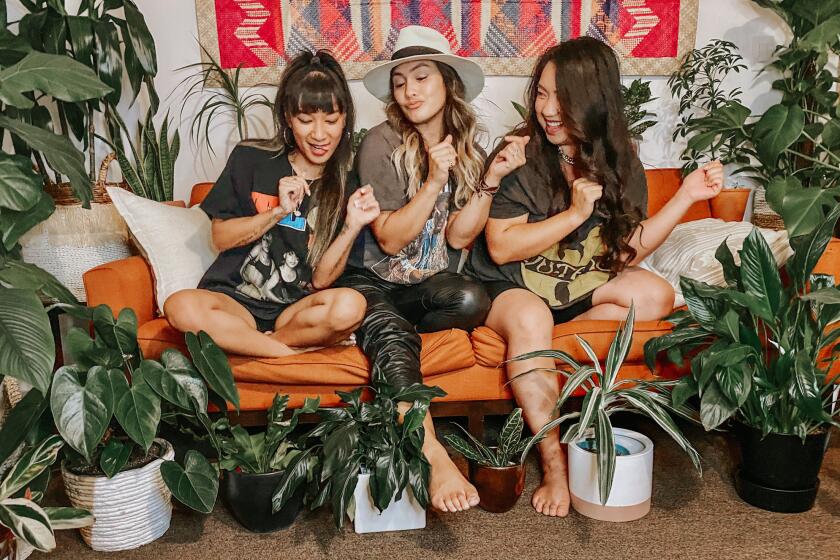‘I’m a neighbor, your confidante.’ Meet Leimert Park’s succulent stylist extraordinaire
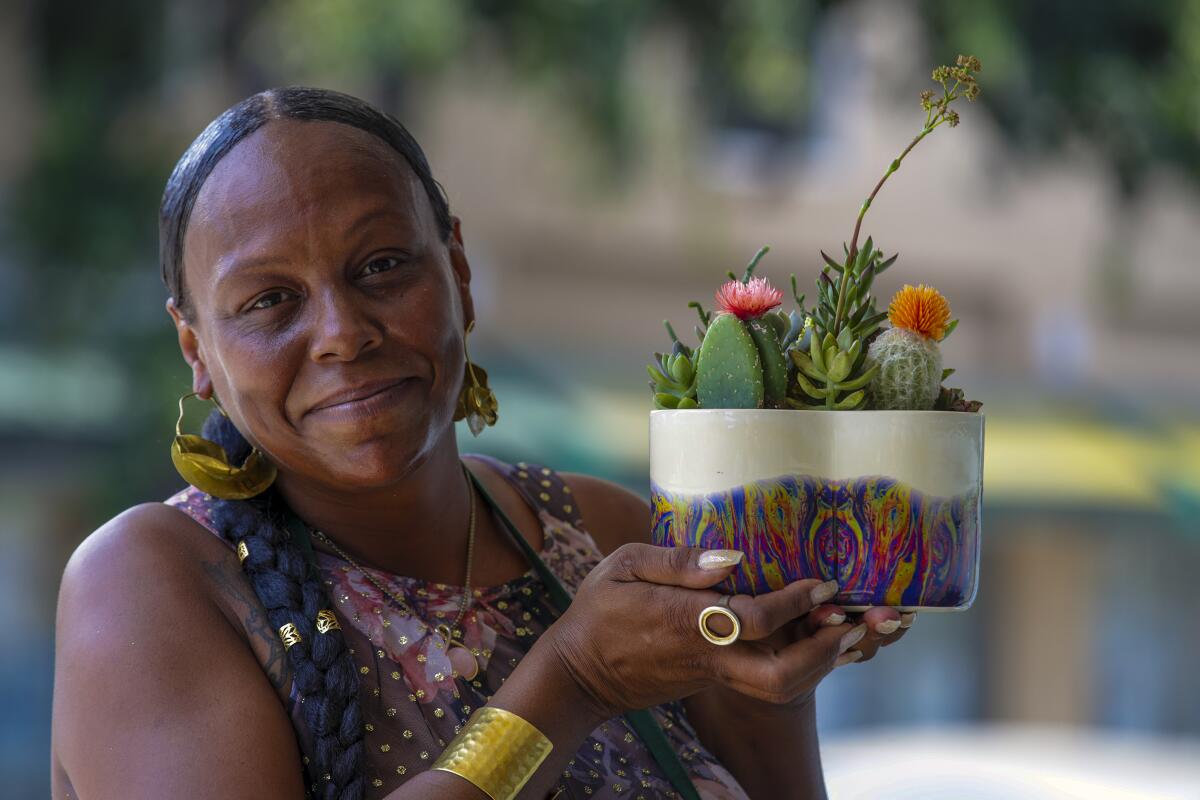
This is the latest in a series we call Plant PPL, where we interview people of color in the plant world. If you have any suggestions for PPL to include in our series, tag us on Instagram @latimesplants.
Every weekend morning, residents of L.A.’s Leimert Park Village community can expect to see La Nola Smith tending to her succulent stand, South Central Succs, just outside the front window of the Ivory Coast Hair Salon at 43rd Street and Degnan Boulevard.
Smith, a spoken-word artist, in-home healthcare aide and mother in addition to her role as owner and sole employee of South Central Succs, opens the outdoor succulent arrangement shop at 9 a.m. every Saturday and Sunday. It remains open until 6 p.m. or whenever loyal customers and intrigued members of the close-knit community decide it’s time to return home.
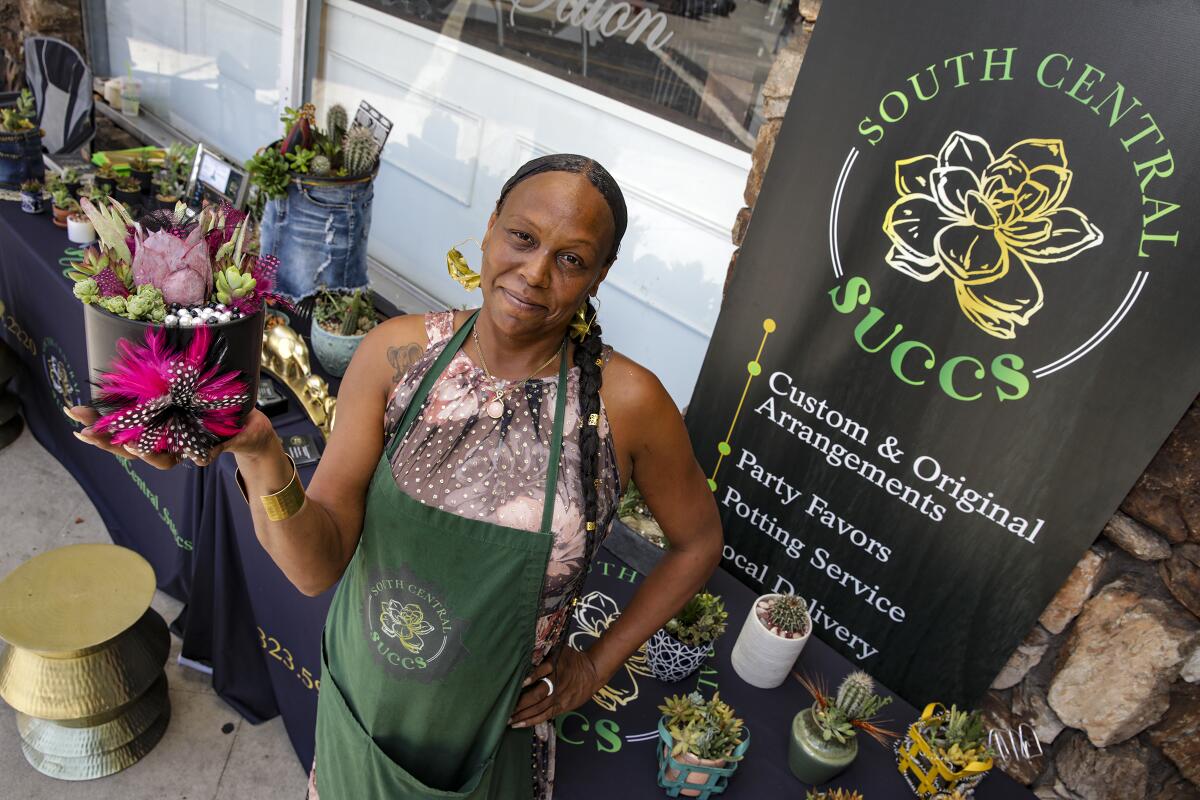
Atop a long table draped in a black tablecloth embroidered with South Central Succs’ green and gold logo sit more than a dozen colorful, intricate succulent arrangements — all for sale and carefully pieced together by Smith at her Leimert Park home. Each arrangement involves multiple succulent and cactus plants surrounded by recycled accents such as shiny broken glass, loose beads and whimsical animal figurines.
In our Plant PPL series, we interview people of color in the plant world, including plantfluencers, plant stylists, floral artists, enthusiasts, experts and garden store owners.
The pots and planters that attempt to contain Smith’s living art pieces are just as fantastical and unique: everything from pots wrapped in bedazzled denim skirts to those accented with tulle covered in craft-store pom-poms to upcycled mugs and teapots.
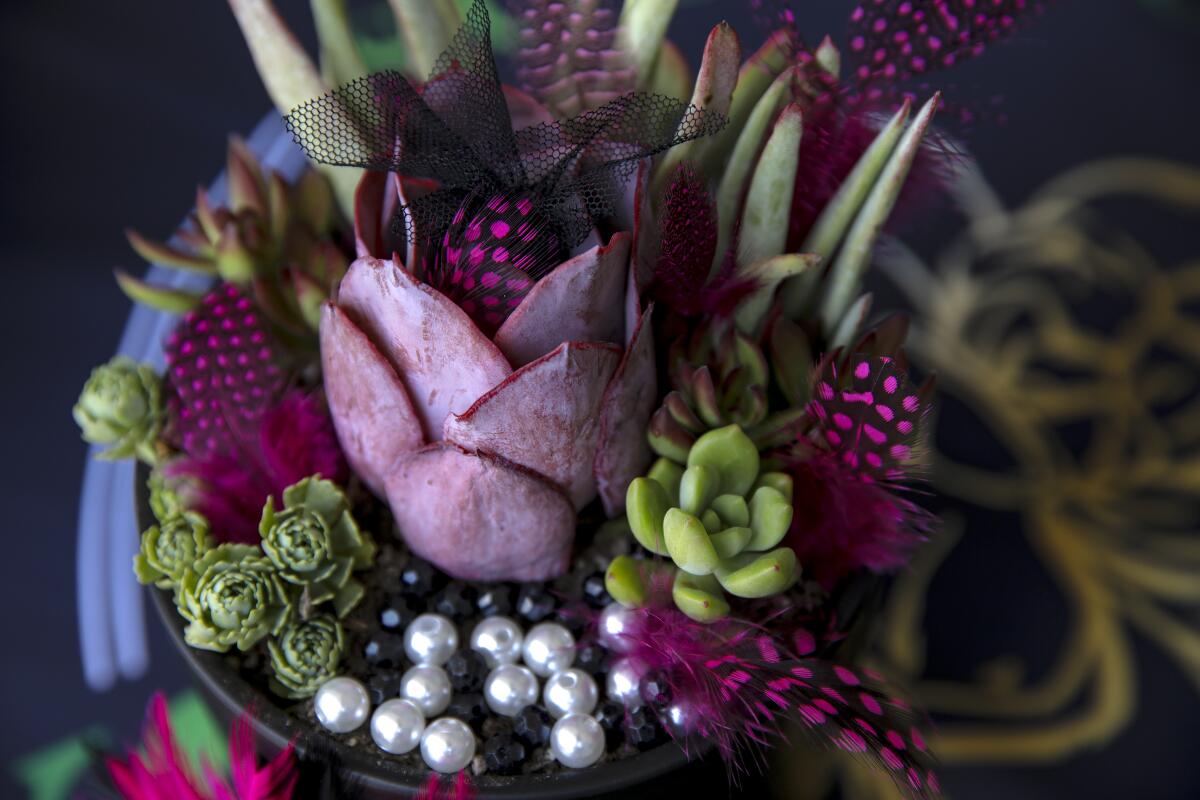
But these creations are only one part of what draws everyone from young children to community elders to South Central Succs.
“Though I sell plants and succulent arrangements, people come by just for the community,” Smith said. “That’s the one thing that surprised me. They gather on my corner, and it’s the funniest thing: Elderly gentlemen talk about medication and expenses and healthcare. And I’m like, ‘Go ahead, enjoy yourselves. Talk, come together. I’m glad you can enjoy yourselves here.’”
Meet Sheryl Calipusan Ung, Janessa Molina Maquindang and Melissa Limbago, the Filipina American cousins behind L.A.’s effortlessly cool FlyPlant Shop.
Neighbors spend hours chatting and relaxing in lawn chairs in the lounge area Smith set up near her display table. Customers can order custom arrangements — which Smith has ready for pickup in a week — or shop around while Smith crafts a one-of-a-kind random arrangement. Kids can build clay pots, fashion their own succulent arrangements or learn about “cactus safety” at South Central Succs’ educational SCS Kids workshops.
Despite her success hosting these community events and creating custom arrangements for birthday parties, centerpieces and even a collector of East African art, Smith said her journey to becoming Leimert Park’s succulent stylist extraordinaire was mere happenstance.
“I didn’t start out with the idea of a business,” she said. “It’s a universe I stepped into.”
The origin story of South Central Succs begins less than a year ago when a neighbor gave Smith a cutting from his pencil tree.
She planted the cutting in her yard and began selling its offspring as something to do amid the boredom of the pandemic. As sales increased, friends encouraged Smith to establish a more permanent business among the iconic Leimert Park Village Vendors.
“When I realized it was taking off, I realized I had to give it a name,” Smith recalled. “I played around with different names and settled on South Central Succs. I like the way it rolls off the tongue and I love that it throws people off. Some people read it as ‘South Central success,’ so I take that!”
Soon, South Central Succs’ growth outpaced that of Smith’s original pencil tree cutting, requiring her to incorporate cactuses and succulents from local nurseries into her arrangements.
“I feel great. I feel like I stepped into a role that was made for me,” Smith said of her business. “Every day is a joy. I look forward to getting up, setting up my table and just seeing what the day brings.”
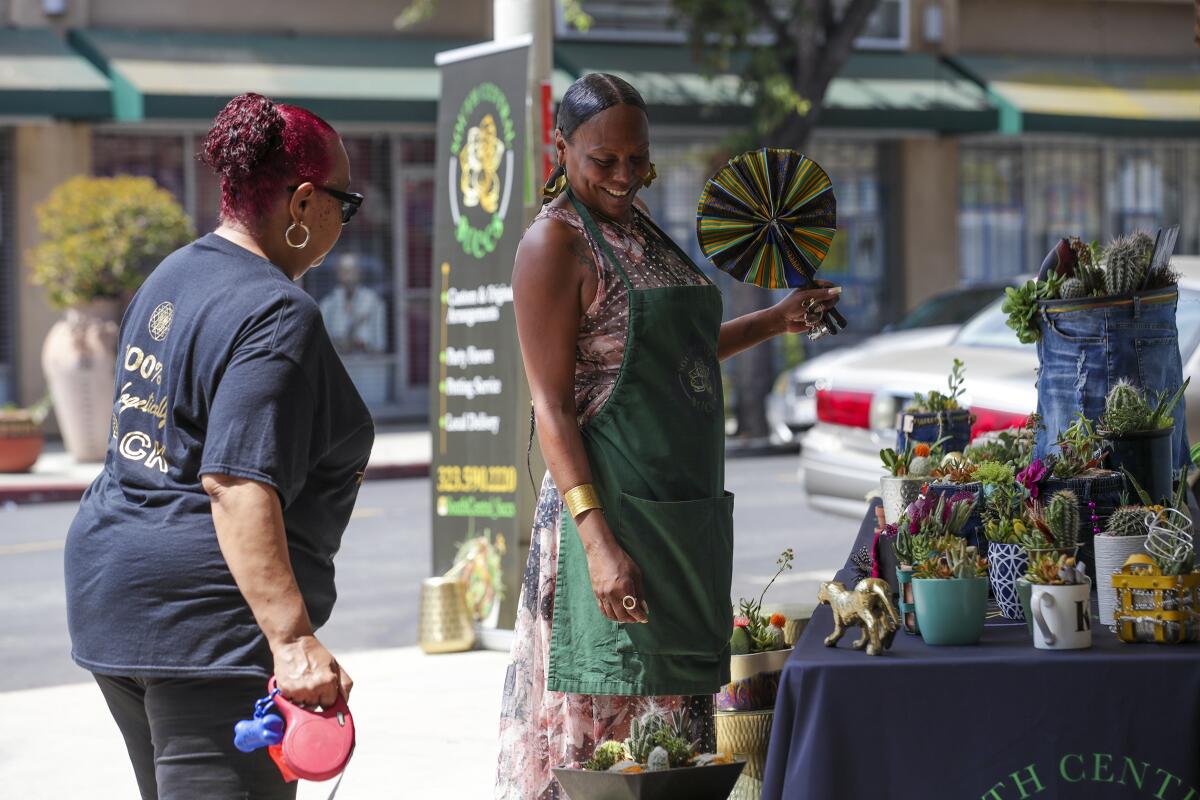
Recently, I interviewed Smith over the phone about the origins of South Central Succs, the inspiration and process behind her creative succulent arrangements and her goals for the business.
This interview has been edited for length and clarity.
What inspired you to found South Central Succs?
It was a time when we were in the pandemic [and there was] not a lot to do. But Leimert Park always has something going on, and I’m always the one out shopping or hanging out and meeting different vendors. People encourage you to come out and be a vendor.
I was like, “OK, let me try. But if I’m going to do it, I’m going to do it according to this vision that I set for myself.”
I started with just cuttings, and when I realized no one was as excited about succulent cuttings as I was, I put them in cups and people bought them, so I said, “Let me run home and make some more.” It just took off from there; the first weekend [I had] 13 customers. Now that was exciting!
Next thing you know, it was like “OK, this is a business.” That’s not what I started with in my mind. I just did it to hang out, be out of the house and socialize. But then I recognized the value that it gave people and the community. Those neighbors look forward to seeing me.
Even if I’m not making sales, I show up, and I make sure I’m there for that morning walk because they expect to see me. So that’s a part of my inspiration. Every weekend, I’m meeting new people and they have new ideas for me.
Everybody hopes to find that one thing, and this found me actually. I didn’t even know I could do this!
How many sales do you average per weekend now?
I see lots of visitors. I may take two to three custom orders a week, which is pretty good for the work that I do. Other than that I may average seven to 10 table sales. I’m still doing well, and I love it.
One thing people ask me — based on my location because I’m not on the main road with the vendors — is if I’m concerned about not getting visitors or customers. My thing is, a slow drip fills a bucket. I love the pace that I’m growing. The lane that I established for myself is definitely more manageable with what my goals are in alignment to my vision. But if it picks up, I’ll keep up!
Tell me more about South Central Succs. What makes you guys unique?
I’m a single owner, and it’s my business. One day, there will be a “you guys,” but right now, it’s just me.
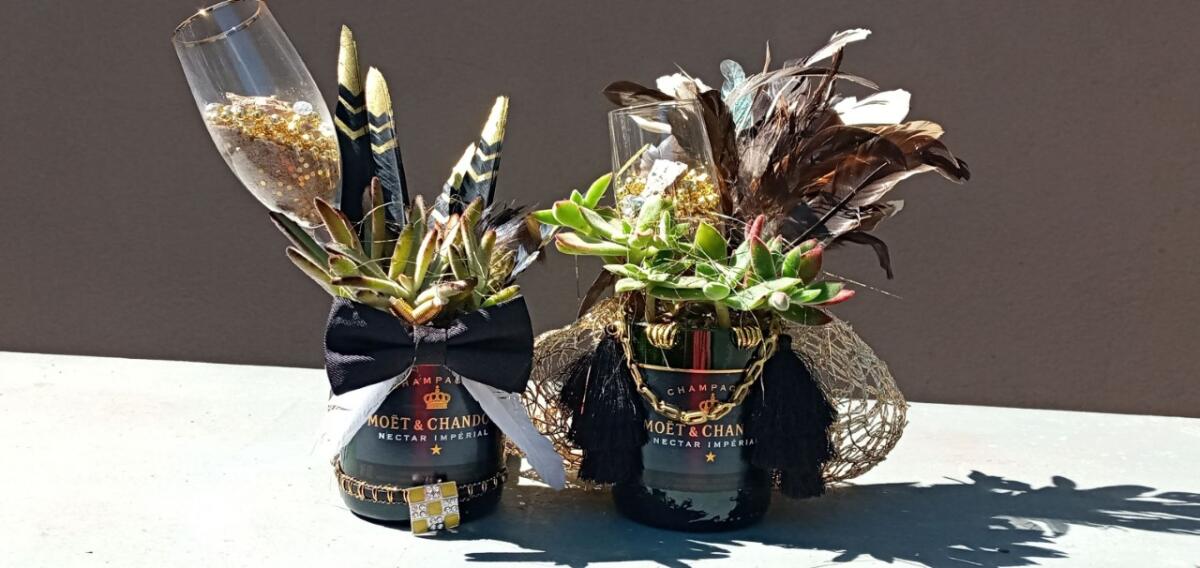
I noticed the trend of everyone having plants. I looked around the yards, and there were plants everywhere … several vendors with plants. And I thought, “OK, if I come out here, how am I going to present this differently? What makes me stand out?”
So I stuck with the cactus and succulents. Though people request [other] plants, I let them know I do not do plants.
Do you think you’ll ever add other plants?
I’m trying to incorporate some, like the snake plant and the spider plant. I’ve incorporated those into some of my work, but I really love the succulents. They’re easier for me to care for and to sustain with respect to storage and transportation, being a vendor. Not if but when I get my storefront, I may create a plant section and create plant arrangements in the same way, so we’ll see.
Tell me more about your plans to get a storefront. Do you have something in the works?
Yeah, that’s part of my vision. My every move is a plan. Every day I go out there is a part of my plan to get to that storefront because every single weekend somebody is presenting me with a new idea or resource. It’s there along my journey.
What is the mission of South Central Succs?
What I’m learning is to learn as I go. I see and respond to what the public seems to say they want. I sell succulent arrangements, but people come by for the community, and I absolutely love to talk to them!
I realized that if I had a seating area, I would have a lounge for people to gather in [for] fellowship. I get that a lot, especially with the elders in the community.
People love and need somebody to talk to. We’re coming out of this pandemic and the isolation. People just want somebody to laugh with or even sit and talk with.
That’s an unexpected benefit and joy I found from this. So my mission is to create a space where people can come, maybe build their own arrangements and just be around. The fellowship — I noticed that’s a need, and I’ve kind of inadvertently provided and fulfilled it.
Can you tell me more about what your community is like?
It is a very close-knit community. I know everyone’s name because I give nicknames to a lot of people. I may not know your name but I know your face.
It’s called Leimert Park Village for a reason. It’s my family; it’s an extended family. I love living here. I love my neighbors. I don’t know if everyone can say that about their neighborhood.
One woman came from out of state, homeless, and she was just amazed at how well received she was and how people came together to make sure she had all the things she needed. It’s very community-oriented.
Artist Nelson ZêPequéno founded @blackmenwithgardens, an Instagram community that amplifies the voices and stories of Black men who garden and care for and enjoy plants.
I am a member of the Leimert Park community, not just a vendor. I’m not a saleswoman; I’m a neighbor, your confidant.
There’s a homeless gentleman. He comes to use my phone. So I make that available to him. I hope to provide some basic things to the community besides just selling succulents and taking up space.
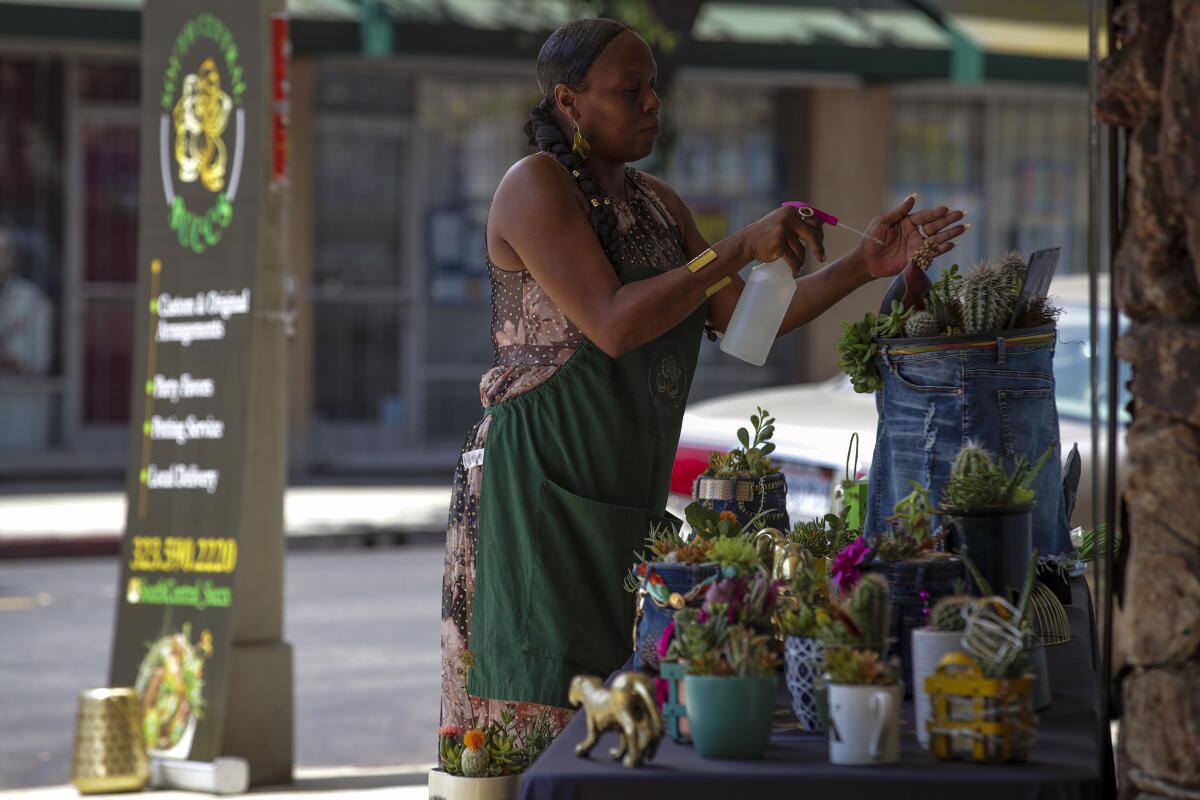
Starting in Leimert Park was no accident. I’m also a poet and a spoken-word artist. The first time I performed onstage was at Leimert Park’s Project Blowed, and now, for me, establishing myself with plants is a new form of expression at this stage I’ve set for myself right at the corner of 43rd and Degnan. It’s like full circle.
You said earlier that the community and your customers give you ideas for improving South Central Succs. What are some examples?
One thing they love are my displays. I have these gold elephant [planters], and because people are so attracted to those displays, one thing I’ve learned is “OK, more gold!” Gold brings them to the table.
Other than that, they suggested I do the plant-and-sips and workshops, so I’m looking for a location for that.
I have a background working with children, and so it’s natural that I’m so fond of the children that pass by. I started giving them free little plants and dirt and things they can go home with and grow on their own. So I’m trying to grow that angle of the business.
What kind of events can SCS Kids get involved in?
I’m trying to establish a table where they can come and build their own arrangements. They take home a few plants, and I’ve had kids who do it come back and say, “My plant is growing!”
For older children, I introduce them to the cactus and cactus safety. With their parents’ permission, I give them a cactus. Regular succulents work better for younger kids. I try to give them something that’s going to evolve sooner than later.
As for the response, parents really love it. It introduces kids and their parents to plants just like with myself. I had no idea what a succulent was when my neighbor suggested it to me. Now, I see they’re actually all around us in L.A.
People call me and say, “I thought of you because I saw this succulent,” or “They got succulents at the grocery store!” What I do is opening other people’s eyes. It’s important that they understand the life that’s all around them. There are not just trees and flowers, there are actually succulents.
Can you tell me about the beautiful succulent arrangements you sell?
My favorite to do are the custom orders. With respect to those, I ask people what general colors they like, what elements, textures or animals. I try to incorporate elements of those into the arrangement.
They’re freestyle though. It’s whatever I feel, whatever is in front of me, whatever materials I have. I may find a bead and create an arrangement around that bead just because I liked that bead … or whatever element I find in the alley behind my house. Sometimes, honestly, I amaze myself with some of the work that I’ve done.
Tell me more about the elements you incorporate into your pieces.
I got a great response from an arrangement I built with a little skirt. People bought it up quickly, and now that’s my new line. I’ll be having skirts!
I like to use materials: clothing, jewelry, broken jewelry, things I find that may look broken. One time, the wind blew [an arrangement] over. I was so devastated, but I said, “You know what, this is actually nice. This part looks good broken up. So now we build something with these broken pieces.”
I just try to find unique objects anywhere. Funny story, there’s a place around the corner where they’re building the Metro train. There’s a little construction site and, while I was over there at the nearby restaurant, I’m seeing these broken chains and rusted nails, and I’m like, “This is going to work for a piece.”
The things that I envision seem to find me. Like I needed that rusted chain, and I walked into a hardware shop thinking I would have to spray paint a chain, and there were rusted chains hanging on their gate. I had to talk them into letting me have one.
What kinds of succulents do you use in your arrangements?
Oh, I keep a variety. I’ll be very honest with you, and I tell all my customers, I am still learning the language of succulents. I appreciate one of the nurseries I go to because [one of the men who works there] is so well informed and teaches me the correct pronunciation of all of them.
It’s another language. And like I said, the one guy, he’s so well versed. He speaks so eloquently, and I do love learning from him.
But with respect to styling them, I know which ones look best. I’m more of a nickname girl, so I have my buttons and my beans, of course, and my string of pearls, string of buttons, echeverias and different types of aloes.
There’s some wonderful colors. There’s burgundies, yellows, golds, even tints of blue.
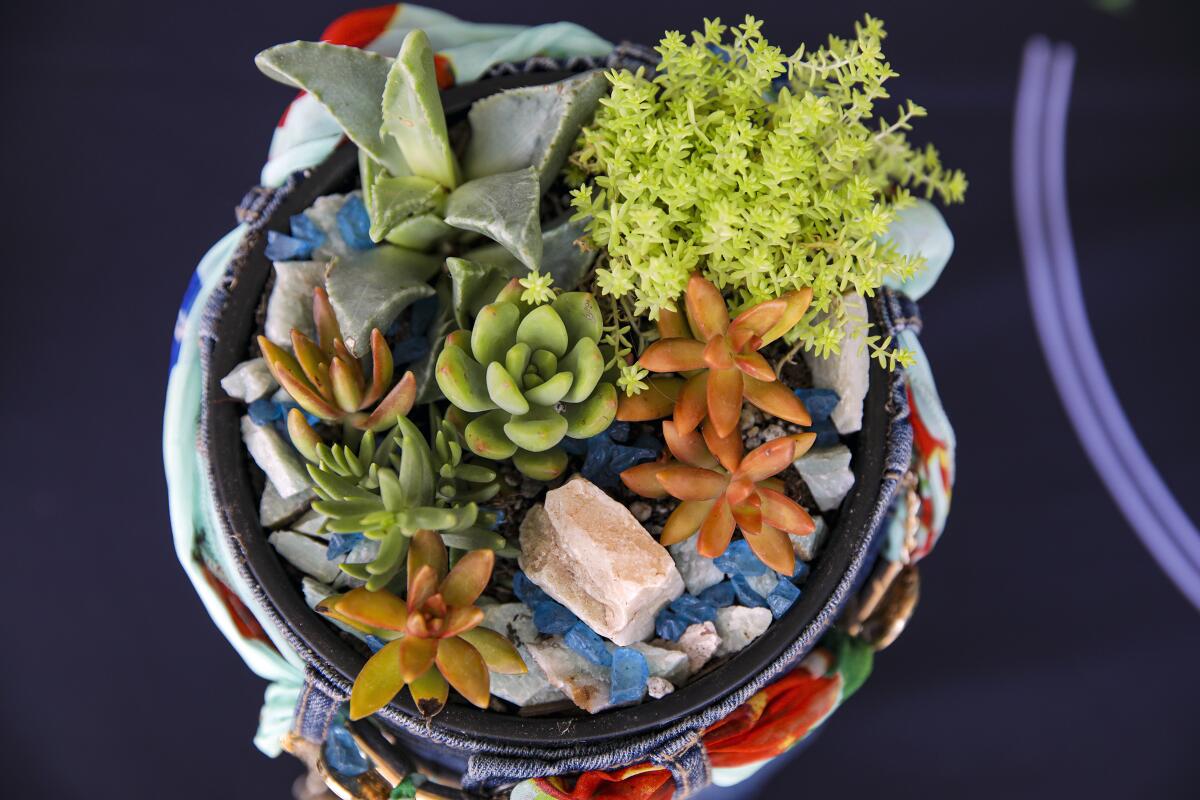
What advice would you give a first-time succulent parent?
Go interesting. Don’t go safe. If you like it, buy it. There’s really no rule to it.
Some people say to play it safe when you buy your plants, you know, get something easy or whatnot. But if it looks interesting, buy it and watch it grow. If you kill it, buy another and start over. Now you know what to do and what not to do.
What are your goals for South Central Succs?
I’ve kind of looked into branching out into having a second table somewhere else for exposure. But I haven’t come across anyone who might be able to maintain it just as I do or offer the same presentation. It’s my baby.
There’s a way that I represent and present myself when I’m interacting with customers, so I think, for now, it’ll probably just be me. Of course, as it grows, I’ll have to bring in people at least in some capacity, but I’m loving my growth right now.
In our Plant PPL series, we interview people of color in the plant world, including plantfluencers, plant stylists, floral artists, enthusiasts, experts and garden store owners.
My ultimate goal — because I’ve seen the impact I’m having on the community using my background in human services and such — I want to create a place where the community can come … a community center with succulents, classes and awareness with plant life as the backdrop. I’m definitely seeing the need for people to have a place to come and talk, fellowship and share ideas with each other. They do it at coffee houses; we’ll do it at a succulent house.
Finally, as we ask everyone in this series, what is your favorite plant?
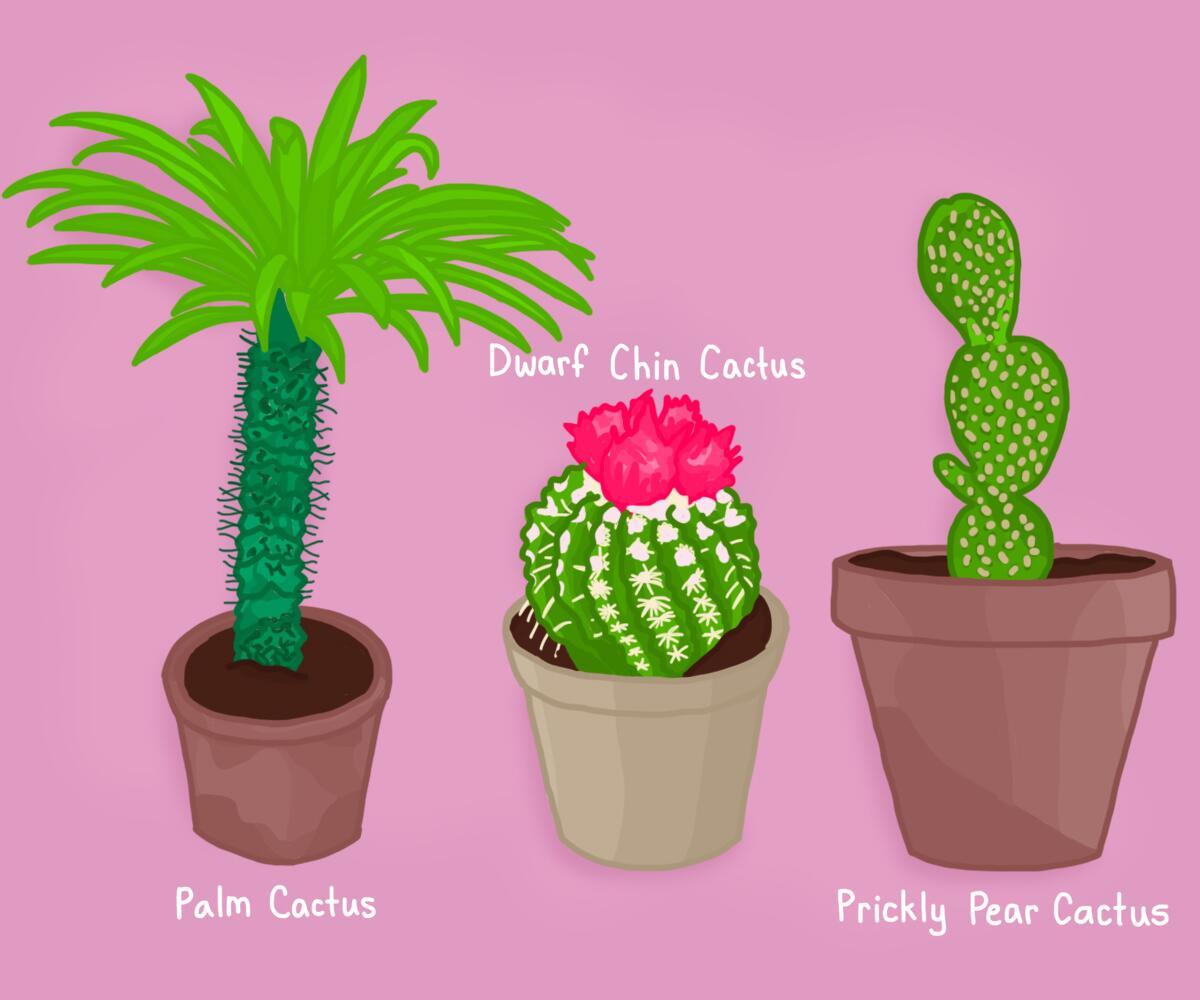
I’m loving the cactus. People call me crazy, but there are some cacti, like the palm, that are kind of therapeutic.
There are some that you can gently touch, and there’s others that will hook onto you and not let go.
I love the different thorns and those with the hairs and the surprise flowers that show up. So that’s where I’m at now — trying to learn all the rare cacti and the different thorns.
More to Read
Sign up for The Wild
We’ll help you find the best places to hike, bike and run, as well as the perfect silent spots for meditation and yoga.
You may occasionally receive promotional content from the Los Angeles Times.
